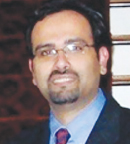More than 60,000 blood and marrow transplants are performed each year worldwide, and the number of long-term survivors is increasing rapidly. But with success has come a host of new issues for patients, providers, and researchers.
“Back when transplants were new, the 1-year mortality rate was high, but now it is generally less than 10%,” said Minoo Battiwalla, MD, of the National Heart, Lung, and Blood Institute (NHLBI), which cosponsored a recent consensus conference on blood and marrow transplant late effects with the National Cancer Institute.

The focus [in blood and marrow transplantation] must now shift. Our challenge is now long-term survival issues.— Minoo Battiwalla, MD
Tweet this quote
Those early deaths were driven by high-dose regimens or poorly controlled acute graft-vs-host disease or infection. But the field has made big strides in managing each of these issues, said Dr. Battiwalla, who is Principal Investigator and Staff Clinician in NHLBI’s Branch.
“The focus now must shift. Our challenge is now long-term survival issues.”
Late effects range from frequent and mild to rare but lethal and can show up months to decades post-transplant. Many are unique to blood and marrow transplantation, such as chronic graft-vs-host disease, which is a powerful driver of other late effects.
“More and more patients are surviving the early complications but still not going back to a normal life,” said Mary Horowitz, MD, Chief of the Division of Hematology and Oncology at the Medical College of Wisconsin and Chief Scientific Director of the Center for International Blood and Marrow Transplant Research. “Many have chronic disability with big financial burdens.”
Key Issues
Four sessions at the conference focused on specific types of late effects. Accompanying background papers identified key issues, as follows.
Subsequent neoplasms: Rates of subsequent neoplasms following transplantation are high, but because of their diversity, the complex treatment history of many transplant survivors, and the need for long-term follow-up, it has been challenging to identify risk factors and mechanisms of pathogenesis and to determine optimal preventive, screening, and therapeutic approaches to reduce their burden.
Cardiovascular and metabolic disorders: Transplant survivors have a three- to fourfold higher risk of developing cardiovascular and metabolic disorders compared to the general population. This increased risk can be associated with therapies, such as chemotherapy with anthracyclines or chest radiation; transplant conditioning regimens; and post-transplant risk factors such as hypertension, diabetes, dyslipidemia, and other metabolic conditions.
Immune dysfunction: Most infections occur during the first year after transplant, but some immunologic deficits are detectable using sensitive immunologic assays at 1 to 2 years and even beyond 10 years. Patients with chronic graft-vs-host disease or cytomegalovirus infection or recipients of human leukocyte antigen–mismatched donors frequently have delayed, incomplete, or dysregulated immune reconstitution. Late infections contribute to mortality.
Quality-of-life and psychosocial issues: Some patients return to their pretransplant physical health status anywhere from 100 days to 1 year following the transplant. But even survivors who are physically doing well may have specific residual deficits, such as sexual or cognitive dysfunction, or financial or emotional problems. More is known about early complications than long-term ones, perhaps because many patients leave the transplant center and return to their primary care providers for long-term care.
Each of these sessions examined the state of the science, identified gaps in knowledge and important research questions, and discussed evidence-based recommendations.
Health-Care Delivery
A fifth major session focused on health-care delivery for long-term survivors, who could number half a million in the United States alone by the year 2030, according to the conference website.1
This session considered various components of survivor care, such as surveillance for disease recurrence and late effects and ongoing management of pretransplant comorbidities. It also looked at various survivor care models, including survivorship care plans, now common for many cancers. Financial issues, including insurance coverage, were a major focus in this group.

NIH support has provided a really good foundation of data on patients, regimens, and early outcomes. Now we need to build on that.— Mary Horowitz, MD
Tweet this quote
A key issue in this area is how best to follow long-term survivors. Transplant centers are required to report outcomes to the Center for International Blood and Marrow Transplant Research annually. However, center-specific outcomes are publicly available only for the first year. Although regular follow-up is a FACT (Foundation for the Accreditation of Cellular Therapy) standard, there is no way to enforce follow-up, and many centers lose track of patients once they move back to their primary care physicians.
“The sad reality is that many transplant clinics do not have routine survivor clinics or any way to follow up on patients,” Dr. Battiwalla said.
The Center for International Blood and Marrow Transplant Research, a voluntary organization founded in 1972, maintains a database that includes thousands of long-term survivors. But the amount of detail available from transplant centers varies, said Dr. Horowitz. “NIH support has provided a really good foundation of data on patients, regimens, and early outcomes. Now we need to build on that,” she said.
Research Methodology
A sixth session at the conference considered research methodology and study design. Papers with findings and recommendations from all sessions are in progress and will be published in Biology of Blood and Marrow Transplantation.
“Together,” Dr. Battiwala said, “they will lay out a road map for late effects research for the next decade.”■
Disclosure: Drs. Battiwala and Horowitz reported no potential conflicts of interest.
Reference
1. National Institutes of Health: NIH Blood and Marrow Transplant Late Effects Consensus Conference. Available at http://epi.grants.cancer.gov/events/blood-marrow-transplant. Accessed July 18, 2016.

